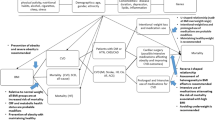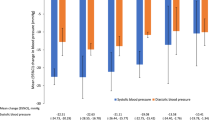Abstract
Objective: Obese patients often present with multiple co-morbid conditions, including hypertension, which are associated with an increased cardiovascular (CV) risk. We aimed to assess the risk factor profiles of primary-care patients with obesity and hypertension in order to estimate their fatal CV risk in total and according to use of various antihypertensive drugs.
Methods: This was a post-hoc analysis of data from a recent observational study involving 72 479 hypertensive patients in 6989 general practices across Germany. Almost all patients (92.3%) were overweight or obese. The 10-year risk for fatal CV events was determined using the SCORE algorithm as published by the European Society of Cardiology.
Results: Overall, 68% of patients had one or more diseases or conditions in addition to obesity and hypertension. The 10-year fatal CV risk was lowest in the youngest normal weight group (1.7%), and highest in the oldest obese group (26%). Men had a higher risk than women, and risk rose with increasing age. The risk factor profile appeared to differ between patients treated with various antihypertensive classes, e.g. angiotensin II type 1 receptor antagonists were associated with lower risk, diuretics with higher risk. There were moderate differences within drug classes.
Conclusions: According to this cross-sectional data, fatal CV risk is strongly increased in obese patients, especially in men and in older age groups. While there were strong associations between use of certain drugs and metabolic risk markers and overall fatal CV risk, the causality of these associations remains to be determined.






Similar content being viewed by others
References
Bramlage P, Pittrow D, Wittchen HU, et al. Hypertension in overweight and obese primary care patients is highly prevalent and poorly controlled. Am J Hypertens 2004; 17(10): 904–10
Bramlage P, Wittchen HU, Pittrow D, et al. Recognition and management of overweight and obesity in primary care in Germany. Int J Obes Relat Metab Disord 2004; 28(10): 1299–308
Solomon CG, Manson JE. Obesity and mortality: a review of the epidemiologic data. Am J Clin Nutr 1997; 66(4 Suppl.): 1044S–50S
Jousilahti P, Tuomilehto J, Vartiainen E, et al. Body weight, cardiovascular risk factors, and coronary mortality: 15-year follow-up of middle-aged men and women in eastern Finland. Circulation 1996; 93(7): 1372–9
Wilson PW, D’Agostino RB, Sullivan L, et al. Overweight and obesity as determinants of cardiovascular risk: the Framingham experience. Arch Intern Med 2002; 162(16): 1867–72
Pi-Sunyer FX. The obesity epidemic: pathophysiology and consequences of obesity. Obes Res 2002; 10Suppl. 2: 97–104S
Frijling BD, Lobo CM, Keus IM, et al. Perceptions of cardiovascular risk among patients with hypertension or diabetes. Patient Educ Couns 2004; 52(1): 47–53
MacMahon S, Cutler J, Brittain E, et al. Obesity and hypertension: epidemiological and clinical issues. Eur Heart J 1987; 8Suppl. B: 57–70
Pittrow D, Kirch W, Bramlage P, et al. Patterns of antihypertensive drug utilization in primary care. Eur J Clin Pharmacol 2004; 60(2): 135–42
Conroy RM, Pyorala K, Fitzgerald AP, et al. Estimation of ten-year risk of fatal cardiovascular disease in Europe: the SCORE project. Eur Heart J 2003; 24(11): 987–1003
Sharma A, Bramlage P, Kirch W. Antihypertensive efficacy of irbesartan and predictors of response in obesity-associated hypertension. Clin Drug Inv 2005; 25(12): 1–11
Hajjar I, Kotchen TA. Trends in prevalence, awareness, treatment, and control of hypertension in the United States, 1988-2000. JAMA 2003; 290(2): 199–206
Mokdad AH, Ford ES, Bowman BA, et al. Prevalence of obesity, diabetes, and obesity-related health risk factors, 2001. JAMA 2003; 289(1): 76–9
Sharma A, Wittchen H, Kirch W, et al. High prevalence and poor control of hypertension in primary care: cross sectional study. J Hypertens 2004; 22: 479–86
Grundy SM, Balady GJ, Criqui MH, et al. Primary prevention of coronary heart disease: guidance from Framingham. A statement for healthcare professionals from the AHA task force on risk reduction. Circulation 1998; 97(18): 1876–87
16. British Cardiac Society, British Hyperlipidaemia Association, British Hypertension Society, et al. Joint British recommendations on prevention of coronary heart disease in clinical practice: summary. BMJ 2000; 320(7236): 705–8
Bramlage P, Pittrow D, Kirch W. The effect of irbesartan in reducing cardiovascular risk in hypertensive type 2 diabetic patients: an observational study in 16 600 patients in primary care. Curr Med Res Opin 2004; 20(10): 1625–31
Wittchen HU, Glaesmer H, Marz W, et al. Cardiovascular risk factors in primary care: methods and baseline prevalence rates. The DETECT program. Curr Med Res Opin 2005; 21(4): 619–30
Janssen I, Katzmarzyk PT, Ross R. Waist circumference and not body mass index explains obesity-related health risk. Am J Clin Nutr 2004; 79(3): 379–84
Wannamethee SG, Shaper AG, Morris RW, et al. Measures of adiposity in the identification of metabolic abnormalities in elderly men. Am J Clin Nutr 2005; 81(6): 1313–21
De Simone G, Wachteil K, Palmieri V, et al. Body build and risk of cardiovascular events in hypertension and left ventricular hypertrophy: the LIFE (Losartan Intervention For Endpoint reduction in hypertension) study. Circulation 2005; 111(15): 1924–31
Lakshman MR, Reda DJ, Materson BJ, et al. Diuretics and betablockers do not have adverse effects at 1 year on plasma lipid and lipoprotein profiles in men with hypertension. Department of Veterans Affairs Cooperative Study Group on Anti-hypertensive Agents. Arch Intern Med 1999; 159(6): 551–8
Guidelines committee. European Society of Hypertension-European Society of Cardiology guidelines for the management of arterial hypertension. J Hypertens 2003; 21: 1011–53
Chobanian AV, Bakris GL, Black HR, et al. The seventh report of the Joint National Committee on Prevention, Detection, Evaluation, and Treatment of High Blood Pressure: the JNC 7 report. JAMA 2003; 289(19): 2560–71
Law MR, Wald NJ, Morris JK, et al. Value of low dose combination treatment with blood pressure lowering drugs: analysis of 354 randomised trials. BMJ 2003; 326(7404): 1427
Sharma AM. Is there a rationale for angiotensin blockade in the management of obesity hypertension? Hypertension 2004; 44(1): 12–9
Bramlage P, Bramlage C, Kirch W. Antihypertensive drug utilisation in obese patients [in German]. Med Klin (Munich) 2005; 100: 804–9
Parving HH, Lehnert H, Brochner-Mortensen J, et al. The effect of irbesartan on the development of diabetic nephropathy in patients with type 2 diabetes. N Engl J Med 2001; 345(12): 870–8
Acknowledgements
This study was funded by a research grant from Sanofi-Aventis Deutschland GmbH, Berlin, Germany. The authors wish to acknowledge the statistical advice provided by Stefan Bruns, Winicker Norimed, Nürnberg, Germany. Peter Bramlage has received consulting fees and research support from Sanofi-Aventis. The other authors have no conflicts of interest that are directly relevant to the content of this study.
Author information
Authors and Affiliations
Corresponding author
Rights and permissions
About this article
Cite this article
Schindler, C., Bramlage, P., Thoenes, M. et al. Cardiovascular Risk in Obese Hypertensive Patients Taking Various Antihypertensive Drugs. Clin. Drug Investig. 27, 707–717 (2007). https://doi.org/10.2165/00044011-200727100-00006
Published:
Issue Date:
DOI: https://doi.org/10.2165/00044011-200727100-00006




